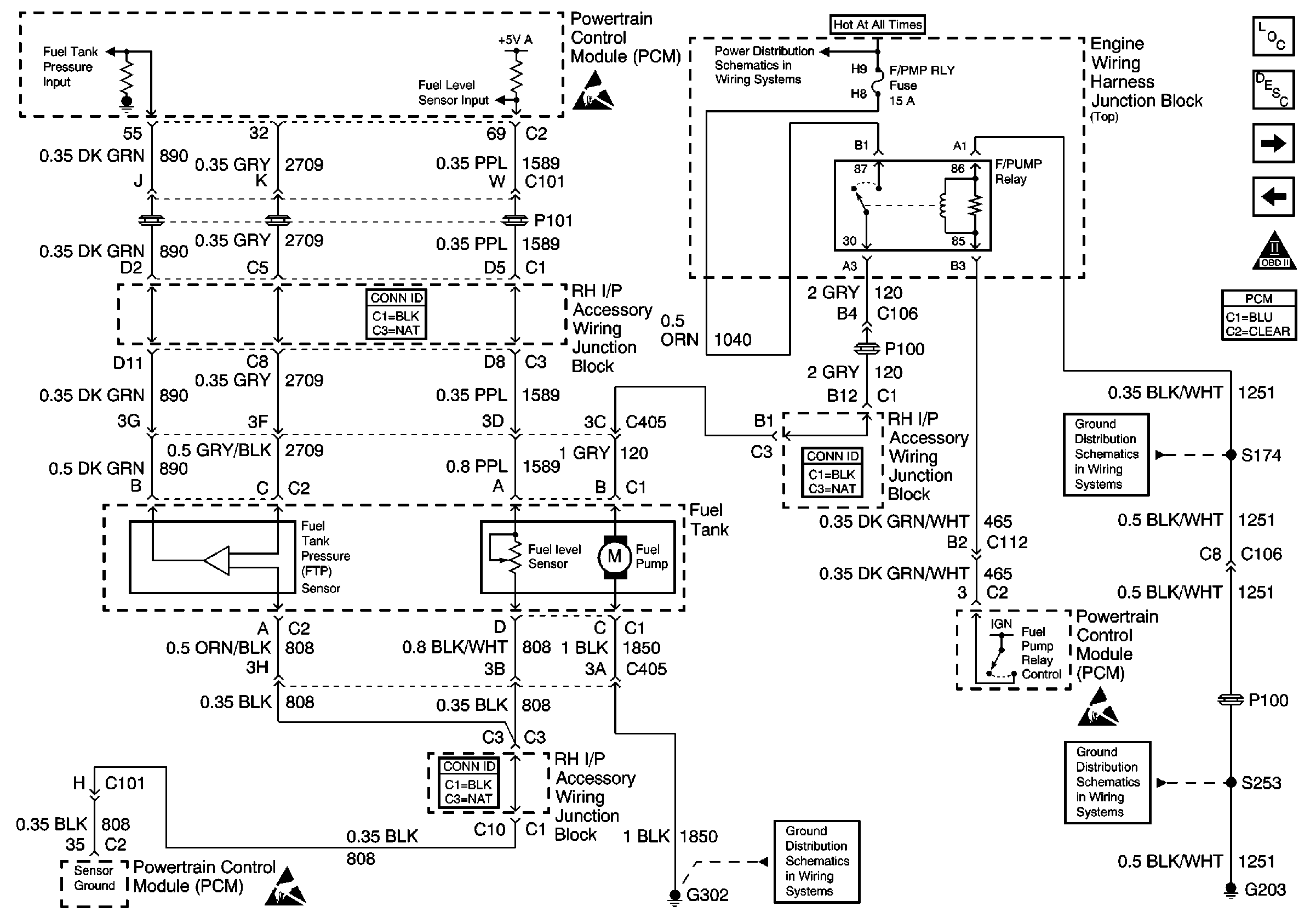Refer to
Fuel Controls

.
Circuit Description
The Powertrain Control Module (PCM) monitors the fuel tank pressure (FTP) sensor signal in order to detect vacuum decay and excess vacuum during the enhanced evaporative emission (EVAP) diagnostic. The fuel tank pressure (FTP) sensor measures the difference between the air pressure, or vacuum, in the tank and the outside air pressure. The PCM applies a 5.0 volt reference and ground to the sensor. The sensor will return a signal voltage between 0.1--4.9 volts. If the PCM detects a fuel tank pressure sensor signal that is excessively low, DTC P0452 will set.
Conditions for Running the DTC
| • | The system voltage is between 10.0--18.0 volts. |
| • | The ignition is ON. |
Conditions for Setting the DTC
| • | The fuel tank pressure sensor signal is less than 0.5 volts. |
| • | The conditions is present for 5 seconds. |
Action Taken When the DTC Sets
| • | The PCM will illuminate the malfunction indicator lamp (MIL) during the second consecutive trip in which the diagnostic test has been run and failed. |
| • | The PCM will store conditions which were present when the DTC set as Freeze Frame/Failure Records data. |
Conditions for Clearing the MIL/DTC
| • | The PCM will turn OFF the malfunction indicator lamp (MIL) during the third consecutive trip in which the diagnostic has run and passed. |
| • | The history DTC will clear after 40 consecutive warm-up cycles have occurred without a malfunction. |
| • | The DTC can be cleared by using a scan tool. |
Diagnostic Aids
Continue the diagnosis at step 4 if you were sent here from one of the EVAP diagnostic tables.
Inspect for the following conditions:
| • | A faulty connection at the PCM or fuel tank pressure sensor-- Inspect harness connectors for: |
| - | Backed-out terminals |
| - | Improper mating |
| - | Broken locks |
| - | Improperly-formed or damaged terminals |
| - | Faulty terminal-to-wire connections |
| • | A damaged harness-- Inspect the wiring harness for damage. |
| If the harness appears to be OK, observe the fuel tank pressure sensor display on the scan tool while moving the connectors and the wiring that are related to the sensor. A change in the display indicates the location of the malfunction. |
Test Description
The numbers below refer to the step numbers on the diagnostic table.
Step | Action | Value(s) | Yes | No |
|---|---|---|---|---|
1 | Did you perform the Powertrain On-Board Diagnostic (OBD) System Check? | -- | ||
2 |
Important: If a 5-volt reference DTC sets, diagnosis that DTC first.
Is the fuel tank pressure less than the specified value? | 0.5 V | ||
3 |
Important: Continue the diagnosis at step 4 if you were sent here from one of the EVAP diagnostic tables.
Does the scan tool indicate DTC P0452 failed this ignition? | -- | Go to Diagnostic Aids | |
4 |
Is the fuel tank pressure near the specified value? | 5.0 V | ||
5 | Use a DMM in order to measure the voltage between the 5-volt reference B circuit and the sensor ground circuit at the fuel tank pressure sensor harness connector. Does the DMM indicate voltage near the specified value? | 5.0 V | ||
6 |
Did you find and correct the condition? | -- | ||
7 | Test the 5 volt reference B circuit between the fuel tank pressure sensor and the PCM for an open, a short to ground, or a short to the sensor ground circuit. Refer to Testing for Intermittent Conditions and Poor Connections and Wiring Repairs in Wiring Systems. Did you find and correct the condition? | -- | ||
8 | Test for faulty terminal connections at the fuel tank pressure sensor connector. Refer to Testing for Intermittent Conditions and Poor Connections and Connector Repairs in Wiring Systems. Did you find and correct the condition? | -- | ||
9 |
Did you find and correct the condition? | -- | ||
10 | Test the fuel tank pressure signal circuit between the fuel tank pressure sensor connector and the PCM for an open, a short to ground, or a short to the sensor ground circuit. Refer to Testing for Intermittent Conditions and Poor Connections and Wiring Repairs in Wiring Systems. Did you find and correct the condition? | -- | ||
11 | Replace the fuel tank pressure sensor. Refer to Fuel Tank Pressure Sensor Replacement . Did you complete the replacement? | -- | -- | |
|
Important: : The replacement PCM must be programmed. Replace the PCM. Refer to Powertrain Control Module Replacement/Programming . Did you complete the replacement? | -- | -- | ||
13 |
Does the scan tool indicate that this diagnostic ran and passed? | -- | System Ok |
